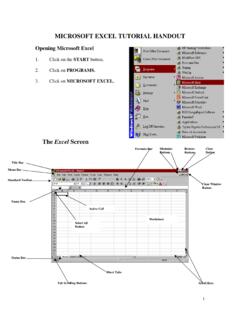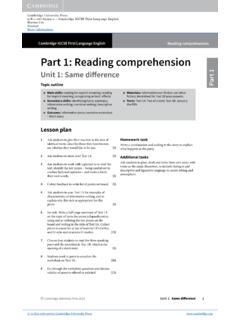Transcription of PracticePractice PuzzlesPuzzles - SharpSchool
1 New York Toronto London Auckland SydneyMexico City New Delhi Hong Kong Buenos AiresFractions and DecimalsbyBob OlenychPuzzlesPuzzlesPracticePracticeMat hMathMath Practice Puzzles: Fractions and Decimals Bob Olenych, Scholastic Teaching ResourcesDEDICATIONTo Paula with all my Inc. grants teachers permission to photocopy the designated reproducible pages from this book forclassroom use. No other part of this publication may be reproduced in whole or in part, or stored in a retrieval system, or transmitted in any form or by any means, electronic, mechanical, photocopying, recording, or otherwise,without written permission of the publisher. For information regarding permission, write to Scholastic Inc., 555 Broadway, New York, NY 10012. Cover design by Kelli ThompsonCover art by Mike MoranInterior design by Melinda Belter Interior illustrations by Steve CoxISBN 0-439-28850-9 Copyright 2001 by Bob Olenych.
2 All rights in the Practice Puzzles: Fractions and Decimals Bob Olenych, Scholastic Teaching ResourcesINTRODUCTION4 FRACTIONSS tudent Reference Pages5 Quick Tips About FractionsEquivalent FractionsBreak the Code 7 Equivalent Fraction Match8 Equal Values 9 comparing and Ordering FractionsGreater Than 10 Least to Greatest11 LCD and Lowest TermsWhat Did the Ocean Say to the Seashore? 12 Find the Match13 Addition and Subtraction(like denominators)Did You Hear?Riddles14 Sticky Code 15 Mixed Number Search16 Addition and Subtraction(unlike denominators)Why Couldn t the Great Houdini Ever Answer the Phone? 17 Low-Grade Infection 18 Humpty Dumpty Riddle19 What s His Reason?20 Let s Fly South21 Multiplication and Division39 Errors 22 Cross Them Out23 Gone Fishing24 Tic-Tac-Toe #125 DECIMALSS tudent Reference Pages26 Quick Tips About DecimalsAddition Surfer Boy28 Crack the Code #129 SubtractionLet s Play Bingo30 What s the Difference?
3 31 Mixed Practice(addition and subtraction)Shapely Math32 Equal Values33 MultiplicationCross-Number Puzzle34 Question and Answer 35 Last Number First Number36 Crack the Code #237 DivisionTic-Tac-Toe #2 38 Division Bingo 39 Mixed Practice (addition, subtraction,multiplication, and division)Decimal Fun 40 Follow the Arrows41 Baseball Trivia42 Fractions and DecimalsDecimal Match 43 Match It 44 Super Challenge45 ANSWER KEY46 Multiplication and Division Practice Can Be SuperFun! Table of ContentsMath Practice Puzzles: Fractions and Decimals Bob Olenych, Scholastic Teaching ResourcesIntroductionMATH PRACTICE PUZZLES FRACTIONS AND DECIMALS4 WORKING WITH FRACTIONS AND DECIMALS CAN BE FUN!When students grasp how fractions and decimals appear in their everyday lives from dividing a chocolate bar intoequal servings to producing change from a money transaction they are ready to work with these concepts in moreadvanced ways.
4 I build on each new understanding and follow up with engaging, self-checking practice exercises likethe ones in this book. WHAT YOU LL FIND IN THIS BOOKThis book offers a collection of 37 fraction and decimal puzzles and activities for a broad range of skills andabilities. The book begins with activitiesinvolving fractions, progresses to decimals,and finally moves into mixed practice. Thepuzzles are arranged according to skill,from easy to difficult. You can match theneeds of your students and target a specificskill by checking the skill description listedboth in the table of contents and under theobjective on each activity ve included some quick-and-easy student reference pages for both fractionsand decimals (pages 5 6 and 26 27). Thesepages teach some useful tips for students as they add, subtract, multiply, and divide fractions, work with equivalent fractions, and express fractions in simplest terms.
5 I ve also provided some tips for thebasic operations with decimals and for converting fractions to TO USE THIS BOOKUse these puzzles in the way that best suits the needs of your class. You may find it helpful to assign certain puzzles as practice work to follow a lesson, as review work, or as homework. You also may want to have students work on different puzzles depending on the skill areas in which each student needs practice. The beauty of these activities isthat almost all of them are self-correcting. Whether they are solving a riddle, breaking a code, or filling in a numberpuzzle, students are encouraged to check each problem so that they can finish the puzzle TO THE MATH STANDARDSMost of the puzzles in this book target NCTM 2000 objectives listed under the Number and Operations objectives include understanding ways to represent numbers, determining meanings of operations and howthey relate to one another, and computing with fluency and accuracy.
6 This book is packed with exercises that requirestudents to use the operations of multiplication and division in a variety of formats, including word problems andmultiple-step m confident that your students, like mine, will enjoy this collection of puzzles and reap the benefits of practicingthese essential skills. Bob OlenychName _____ Date _____6 Scholastic Professional Books Math Practice Puzzles: Fractions and DecimalsCreating Equivalent FractionsSince you can t add or subtract fractions with different denominators, knowing how tomake equivalent fractions is essential. Take!"+!#= _____Because the denominators are different, solving this problem is like adding apples and oranges. Eitheryou need to add in thirds or in ninths how do you choose? Go for the least common denominator (9).You can solve this problem by showing both fractions as ninths. Here s how to change!
7 # into ninths:First, identify the lowest common denominator (the LCD). 9 Ask: What number can I multiply by to get this new denominator? !# x3= "Multiply the numerator by that same number.!# x3= $"So, !#= $" .Now you can solve the problem: !"+ $"= %".Reducing Fractions to Simplest express a fraction in its simplest form, ask: Do the numerator and the denominatorshare any of the same factors? (Can they be divided by any of the same numbers?) the largest common factor and divide both the numerator and the denominatorby that $"Ask: Do the numerator 3 and the denominator 9 share any of the same factors? Answer: Yes! They can both be divided by 3, thelargest common 3=19 3=3So, $"= !# .Student Reference Page: Working With FractionsTips for Creating Equivalent Fractions and Reducing Fractions?Divide the numerator 3 by 3to get the new numerator, the denominator 9 by 3to get the new denominator, do the same tothe numerator as you doto the _____ Date _____5 Scholastic Professional Books Math Practice Puzzles: Fractions and DecimalsTo ADD or SUBTRACT Fract ionsnumeratorsTake&'+$' =_____ denominators&'+$'=('If the denominators of the fractions in the equation are the same, add orsubtract the numerators to find the sum or difference.)
8 Take &)+$*=If the denominators of the fractions in the equation are different, beforeyou add or subtract, create equivalent fractions (see Tips page 6). &)+$*=Make these denominators equal before you add! denominators are different!"+ $*= +*Now you can add this equation!To MULTIPLY Fract ions Take(' x !,= _____(' x!, = -.,To DIVIDE Fract ions Take !/ !, = _____ !, &-Invert the second fraction of the equation.!/ x&-= &/Tips for Adding, Subtracting, Multiplying, and Dividing FractionsStudent Reference Page: Working With FractionsMultiply numeratorsMultiply denominatorsMultiply numerators Multiply denominators &)= %*EQUIVALENTFRACTIONSTo CON VERT Fract ions to Decimals If you re working with a fraction with the denominator 10, 100, or 1000: the number of zeros inthe the number of zeros youcounted to show the number ofdecimal places you ll need inyour if the denominator is not 10, 100, or 1000 (or any multiple of 10), create equivalent fractions thatshow tenths, hundredths, or = =.
9 4 Here, 5 is a factor of 10. Create an equivalent fraction with = =.75 Here, 4 is a factor of 100. Create an equivalent fraction with = =.125 Here, 8 is a factor of 1000. Create an equivalent fraction with for Converting Fractions to DecimalsName _____ Date _____Student Reference Page27 Scholastic Professional Books Math Practice Puzzles: Fractions and Decimals-9:= .71decimal place (tenths)-;:<:= .122decimal places (hundredths)-=:9:>:= .3743decimal places (thousandths)To ADD or SUBTRACT DecimalsTake + + + 22 = _____ Line up the decimal points of each numberwhen you write the problem zeros to act as a decimal point if you add zeros to+ the decimal point down in your MULTIPLY DecimalsTake = _____ Set up the problem and multiply as you would with whole places Count the number of decimal places in the place All together there are 3decimal the same number of places in the answer (3decimal places).
10 To DIVIDE DecimalsWhen you divide, your divisor must be a whole number. If the dividend has a decimal, placea decimal point directly above the decimal point in the answer. Divide to solve the 3 = ____3 The dividend has a decimal. Place a decimal point in your answer directly above the decimal point in the the divisor has a decimal, change it to a whole number by moving the decimal point to theright. Count the number of spaces you moved Move the decimal one place to the right to make a whole adjust the dividend by moving the decimal to the right the same number of Now you can divide, noting the new position of the decimal point in your answer. Tips for Adding, Subtracting,Multiplying, and Dividing DecimalsName _____ Date _____Student Reference Page: Working With Decimals26 Scholastic Professional Books Math Practice Puzzles: Fractions and + 22_____HintIf your place values are notaligned when you add or subtract with decimals, you ll getthe wrong answer!






